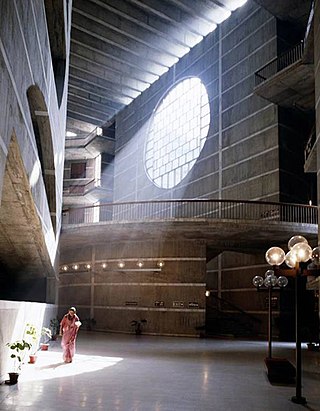Related Research Articles

An incandescent light bulb, incandescent lamp or incandescent light globe is an electric light with a wire filament that is heated until it glows. The filament is enclosed in a glass bulb that is filled with vacuum or inert gas to protect the filament from oxidation. Current is supplied to the filament by terminals or wires embedded in the glass. A bulb socket provides mechanical support and electrical connections.

Energy conservation is the effort to reduce wasteful energy consumption by using fewer energy services. This can be done by using energy more effectively or changing one's behavior to use less service. Energy conservation can be achieved through efficient energy use, which has some advantages, including a reduction in greenhouse gas emissions and a smaller carbon footprint, as well as cost, water, and energy savings.

A compact fluorescent lamp (CFL), also called compact fluorescent light, energy-saving light and compact fluorescent tube, is a fluorescent lamp designed to replace an incandescent light bulb; some types fit into light fixtures designed for incandescent bulbs. The lamps use a tube that is curved or folded to fit into the space of an incandescent bulb, and a compact electronic ballast in the base of the lamp.

India is the third largest producer of electricity in the world. During the fiscal year (FY) 2022–23, the total electricity generation in the country was 1,844 TWh, of which 1,618 TWh was generated by utilities.

Architectural lighting design is a field of work or study that is concerned with the design of lighting systems within the built environment, both interior and exterior. It can include manipulation and design of both daylight and electric light or both, to serve human needs.

Rural electrification is the process of bringing electrical power to rural and remote areas. Rural communities are suffering from colossal market failures as the national grids fall short of their demand for electricity. As of 2019, 770 million people live without access to electricity – 10.2% of the global population. Electrification typically begins in cities and towns and gradually extends to rural areas, however, this process often runs into obstacles in developing nations. Expanding the national grid is expensive and countries consistently lack the capital to grow their current infrastructure. Additionally, amortizing capital costs to reduce the unit cost of each hook-up is harder to do in lightly populated areas. If countries are able to overcome these obstacles and reach nationwide electrification, rural communities will be able to reap considerable amounts of economic and social development.

An LED lamp or LED light is an electric light that produces light using light-emitting diodes (LEDs). LED lamps are significantly more energy-efficient than equivalent incandescent lamps and can be significantly more than most fluorescent lamps. The most efficient commercially available LED lamps have efficiencies exceeding 200 lumens per watt (lm/W) and convert more than half the input power into light. Commercial LED lamps have a lifespan several times longer than both incandescent and fluorescent lamps.

The Ministry of New and Renewable Energy (MNRE) is a ministry of the Government of India, headed by current Union Cabinet Minister Raj Kumar Singh, that is mainly responsible for research and development, intellectual property protection, and international cooperation, promotion, and coordination in renewable energy sources such as wind power, small hydro, biogas, and solar power.

Various governments have passed legislation to phase out manufacturing or importation of incandescent light bulbs for general lighting in favor of more energy-efficient alternatives. The regulations are generally based on efficiency, rather than use of incandescent technology. However, it is not unlawful to continue to buy or sell existing bulbs, which are unregulated.

Power Finance Corporation Ltd. is an Indian central public sector undertaking under the ownership of the Ministry of Power, Government of India. Established in 1986, it is the financial backbone of Indian power sector. PFC's net worth as on 30 June 2023 is INR 1,184 billion. PFC is the 8th highest profit making Central Public Sector Undertaking (CPSU) as per the Department of Public Enterprises Survey for FY 2017–18. PFC is India's largest NBFC and also India's largest infrastructure finance psu. Government has raised status of PFC from ' Navratna' to 'Maharatna' psu on 12 October 2021.

REC Limited, formerly Rural Electrification Corporation Limited, of which Power Finance Corporation Limited (PFC) is holding company, which in turn is under the ownership of the Ministry of Power, the Government of India. It finances and promotes power projects across India. The PSU provides loans to Central/State Sector Power Utilities in the country, State Electricity Boards, Rural Electric Cooperatives, NGOs and Private Power Developers. On 20 March 2019, PFC signed the agreement to acquire a 52.63% controlling stake in REC for ₹14,500 crore (US$1.8 billion). On 28 March, PFC announced that it had completed making the payment for the acquisition and intended to merge REC with itself in 2020. However, REC has maintained that merging PFC-REC is no longer an option.

Piyush Vedprakash Goyal is an Indian politician and chartered accountant serving as a cabinet minister in the Government of India, having portfolios such as Minister of Textiles, Minister of Commerce and Industry and Minister of Consumer Affairs, Food and Public Distribution. He was elevated to the Cabinet Minister position on 3 September 2017. Currently a Member of Parliament for Rajya Sabha from the state of Maharashtra, he is also the current Leader of the House in Rajya Sabha.
United States Lighting Energy Policy is moving towards increased efficiency in order to lower greenhouse gas emissions and energy use. Lighting efficiency improvements in the United States can be seen through different standards and acts. The Energy Independence and Security Act of 2007 laid out changes in lighting legislation for the United States. This set up performance standards and the phase-out of incandescent light bulbs in order to require the use of more efficient fluorescent lighting. EISA 2007 is an effort to increase lighting efficiency by 25-30%. Opposition to EISA 2007 is demonstrated by the Better Use of Light Bulbs Act and the Light Bulb Freedom of Choice Act. The efforts to increase lighting efficiency are also demonstrated by the Energy Star program and the increase efficiency goals by 2011 and 2013. A ban on the manufacture and sale of most general purpose incandescent bulbs in the U.S. took effect on August 1, 2023.

Tata Power Delhi Distribution Limited (TPDDL), is a joint venture between the Government of NCT of Delhi and Tata Power Company Limited, which holds a 51% majority stake in the venture.

The Sagarmala Programme is an initiative by the Government of India to enhance the performance of the country's logistics sector. The programme envisages unlocking the potential of waterways and the coastline to minimize infrastructural investments required to meet these targets.

Energy Efficiency Services Limited is a joint venture of state-run power companies, responsible for implementation of the Unnat Jyoti by Affordable LEDs for All scheme, formerly known as the Domestic Efficient Lighting Programme. It has reduced the prices of LED bulbs by 75%.

Pradhan Mantri Ujjwala Yojana was launched by Prime Minister of India Narendra Modi on 1 May 2016 to distribute 50 million LPG connections to women of Below Poverty Line (BPL) families. A budgetary allocation of ₹80 billion (US$1.0 billion) was made for the scheme. The scheme was replaced by the Ujjwala Yojana 2.0 in 2021.
National Action Plan for Climate Change (NAPCC) is a Government of India's programme launched in 2008 to mitigate and adapt to the adverse impact of climate change. The action plan is designed and published under the guidance of Prime Minister’s Council on Climate Change (PMCCC). The 8 sub-missions aimed at fulfilling India's developmental objectives with focus on reducing emission intensity of its economy. The plan will rely on the support from the developed countries with the prime focus of keeping its carbon emissions below the developed economies at any point of time. The 8 missions under NAPCC are as follows:
References
- ↑ "Government of India's UJALA & Street Lighting National Programme Complete Five Successful yearso f Illuminating India".
- ↑ "About UJALA" (PDF). www.ujala.gov.in. Archived from the original (PDF) on 13 December 2020. Retrieved 14 January 2020.
- ↑ "Government of India's UJALA & Street Lighting National Programme Complete Five Successful yearso f Illuminating India".
- ↑ "UJALA – Energy Efficiency Services Limited".
- ↑ "UJALA – Energy Efficiency Services Limited".
- ↑ "UJALA scheme: Over 25 crore LED bulbs distributed under UJALA scheme: EESL - The Economic Times". The Economic Times. Retrieved 3 January 2018.
- ↑ "Himachal Promotes Energy Efficiency, Launches 'Ujala' Scheme - News18". News18.com. 29 March 2017. Retrieved 3 January 2018.
- ↑ "75L LED bulbs distributed so far under UJALA scheme: Govt". Dailypioneer.com. Retrieved 3 January 2018.
- ↑ "India's 'Ujala' to light up UK homes". The Times of India. 14 May 2017. Retrieved 3 January 2018.